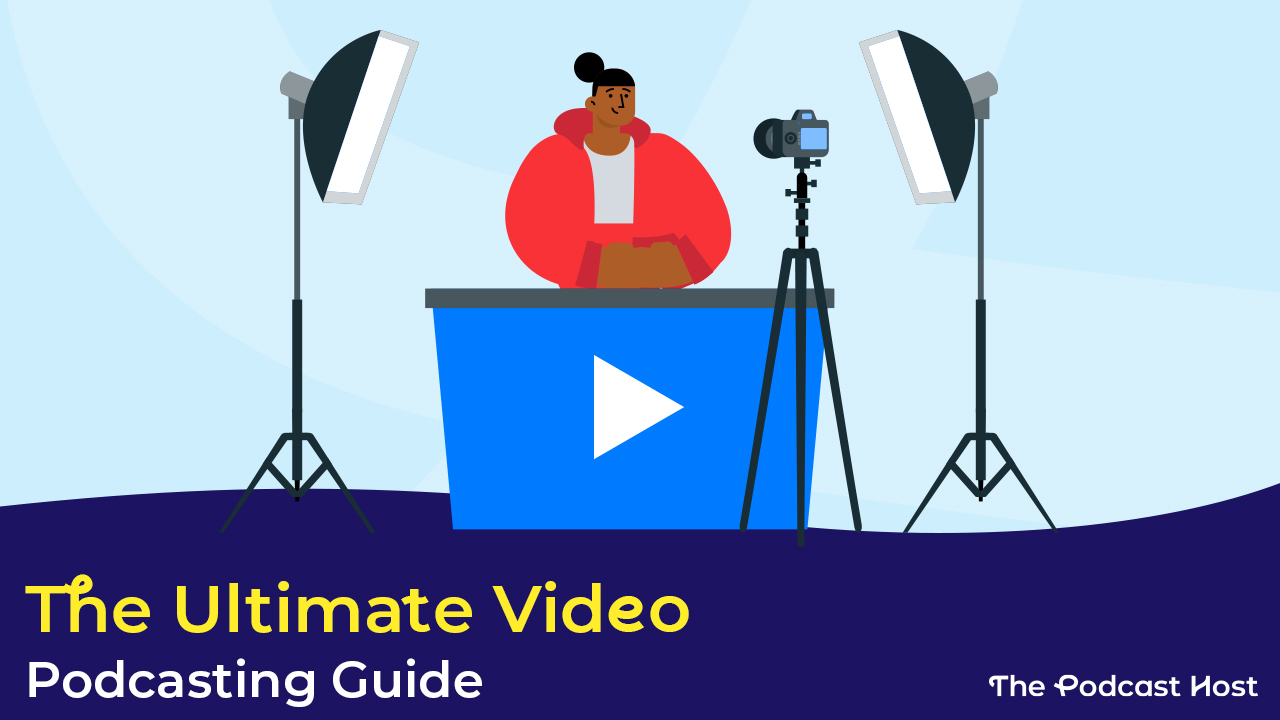Descript Review: Transcription, Overdubbing, & Video Podcasts

Descript review: at a glance
- Descript, like all podcast maker apps, offers a simple way to start podcasting.
- Recording and editing are non-destructive.
- Transcription happens at the recording stage, or when you upload your audio file to the app.
- Overdub, the synthesized voice feature, is unsettlingly accurate.
- Descript emphasizes a recording’s text, using a word-processing-style editing interface.
- Video editing has templates that can save hours of time, and a script-based interface that’s easy to understand.
- Filler word removal: at all price tiers Descript takes out “um” and “uh.” At the pro level, Descript can pinpoint and remove up to eighteen filler and/or repeated words.
- Read on for the full review, including screenshots, pricing, and final thoughts.
Descript can be referred to as a podcast-maker app. There are a few similar tools on the market, as you’ll see in our dedicated roundup. What sets Descript apart, though, are its text-based editing and stable of pre-recorded AI voices. The Overdub feature garnered the most attention initially; users can edit the text to create new words in their own voice. This empowers people who can’t verbalize but still want to make a podcast. Since its inception, Descript has grown along with its users. They’ve expanded their audio editing features and include video recording and video editing features, with templates and stock scenes. In this Descript review, we’ll go over the pros and cons to find out if this app is right for you.
In the interest of full disclosure, we here at The Podcast Host have a sister company that runs a podcast maker app, Alitu. However, we’re always committed to fair and impartial reviews, no matter what the context. After all, there’s never any “one size fits all” option in podcasting.
So, Who is Descript For?
Podcast-maker apps like Descript or Alitu are geared towards folks who’re either new to podcasting, or short on time. Or, both.
Most new creators have no desire to spend time learning detailed podcast editing software or DAWS (i.e., Audacity or Logic). Though if you are interested in those, we have a roundup of the Best Podcasting Software. These are tools that you would use to customize all aspects of the audio editing experience. In the long run, they’ll give you greater flexibility and control. But the trade-off is a steep learning curve, as well as a whole load of trial and error.
So, now that we know who it’s for, what does it actually do?
What Projects Can Users Make with Descript?
Originally, Descript was a great program for recording, transcribing and editing audio files in English. Now, with Descript, you can:
- Use automatic transcription to clarify podcasts or videos in over 23 languages
- Record, edit and polish audio or video
- Use templates to make videos with aspect ratios to fit social media or YouTube
- Include high-quality stock video footage
- Use video effects and green screen layers
- Use many different voices to bring your creation to life
- Train an Overdub voice to match yours, so you can make podcast episodes in your own voice simply by typing
Again, Descript has evolved through working with customers. Their Discord Community, Creator HQ and live events help them add and change features to improve the editing process.
Descript Download
The first thing you’ll need to do before you can try Descript is to download and install it. It isn’t a browser-based program. You can get started for free by either signing up or signing in. It works like most other downloads: you pick a location on your computer, it’ll drop a zip file into it, and that’ll open the Descript installer, which walks you through the rest of this short and easy process.
Descript Review: Recording and Audio Editing
You can record your own voice in Descript, or import an audio file (no call recording as of yet). Descript transcribes it and saves it as one track.
Descript uses non-destructive editing. If you make a mistake while editing, it’s okay: your original version is backed up in the library. You won’t do permanent damage to your sound files.
Essentially, you edit your audio in Descript the same way that you would edit a document. Along with this, you can see the waveforms and tracks at the bottom of the screen.
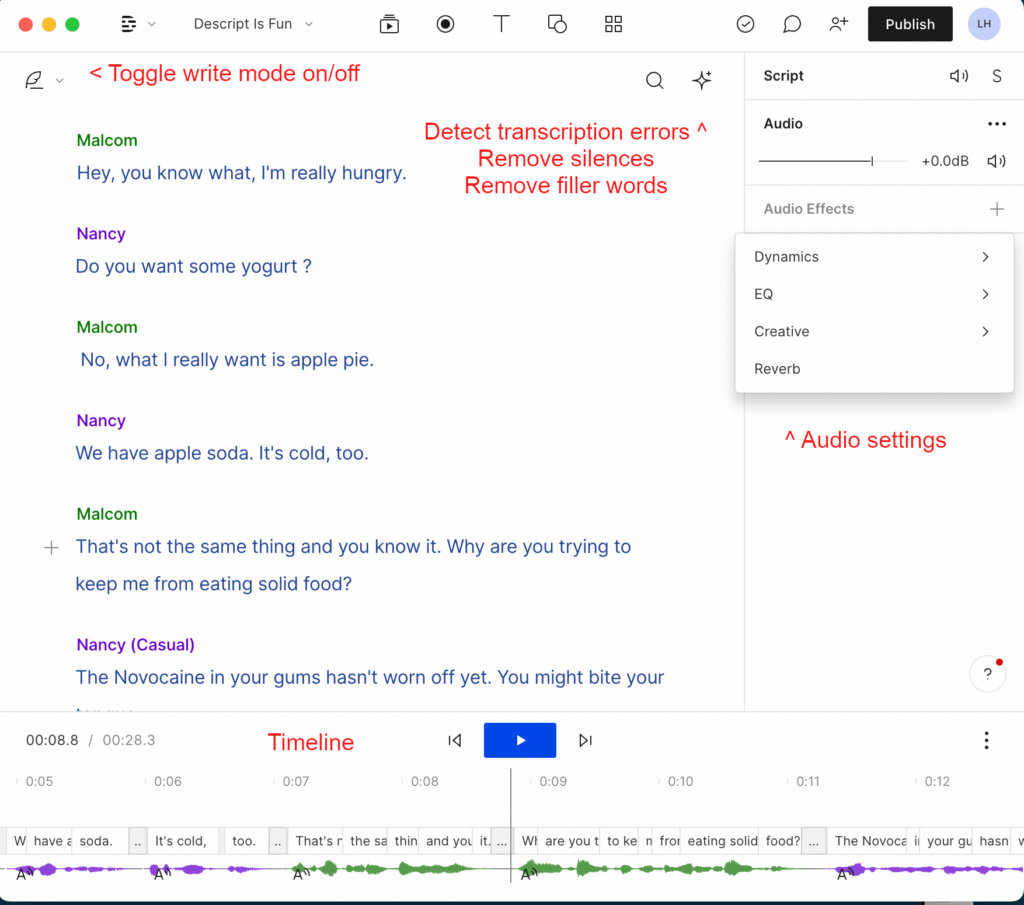
You can add some sound polishing options, such as reverb, EQ or compression.
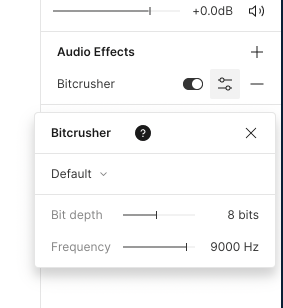
Descript Review: Automatic Transcription
Since Descript’s editing process is text-based, transcription is the first step after recording your audio or video files. The transcripts are fairly accurate, but correcting the audio recordings is easy if necessary. Just click on the word you want to fix, select “Correct,” and type in the right word.
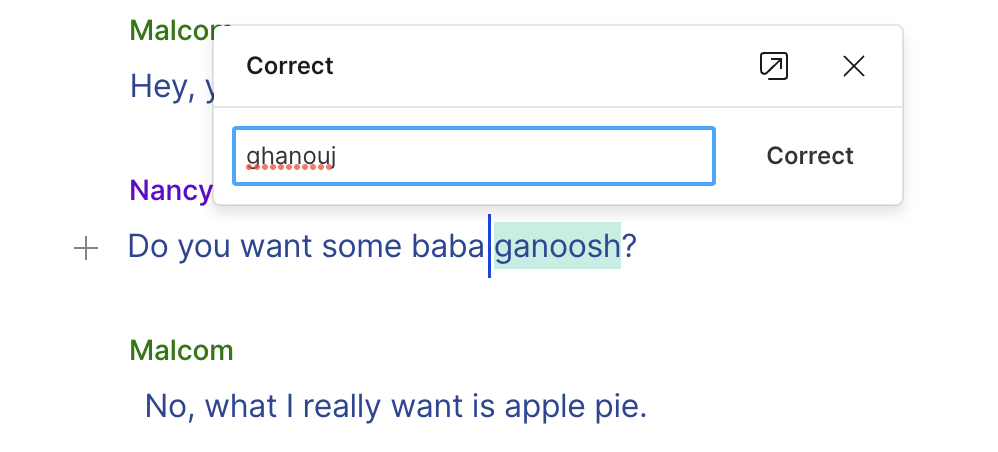
Descript Can Produce an Episode With Your Content and a New Voice
Maybe you want to keep your podcast separate from your day job, or you have other reasons for needing privacy. Maybe, like Roger Ebert, speaking your mind has gained you a following, but physical health issues require a shift to nonverbal communication. Descript has a list of voices to choose from, once you’ve entered the text you want the voice to speak. Choose how you want to build your composition: either record audio, upload a pre-recorded audio file, copy and paste the text from another document, or start writing.
Then you can select the Speaker from a list of nine different voices. If you have multiple speakers, you’ll need to select their Speaker labels to match their new lines of dialogue.
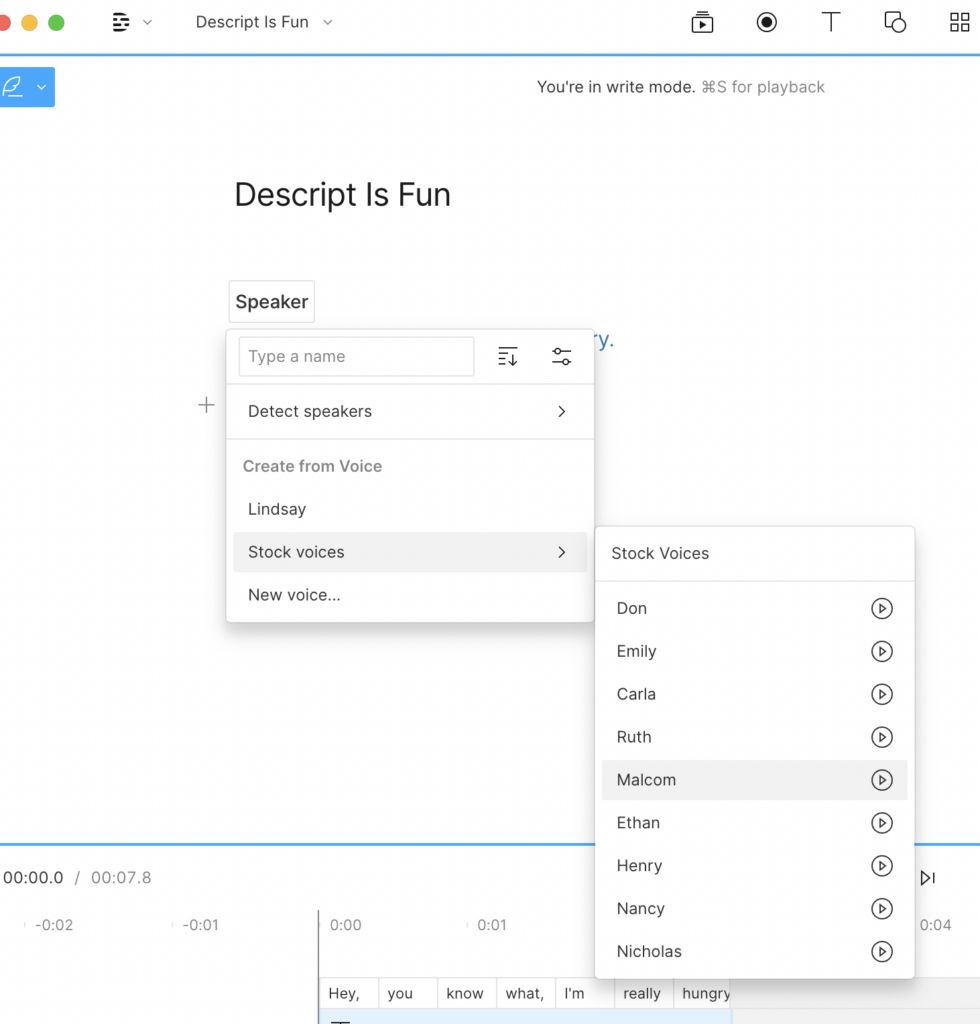
The Overdub voices are available in English, and some have different emotions.
Changing Audio With Descript’s Overdub
Nancy, the Descript voice, can’t seem to pronounce “baba ghanouj” correctly, so I decided it would be better if she suggested yogurt.
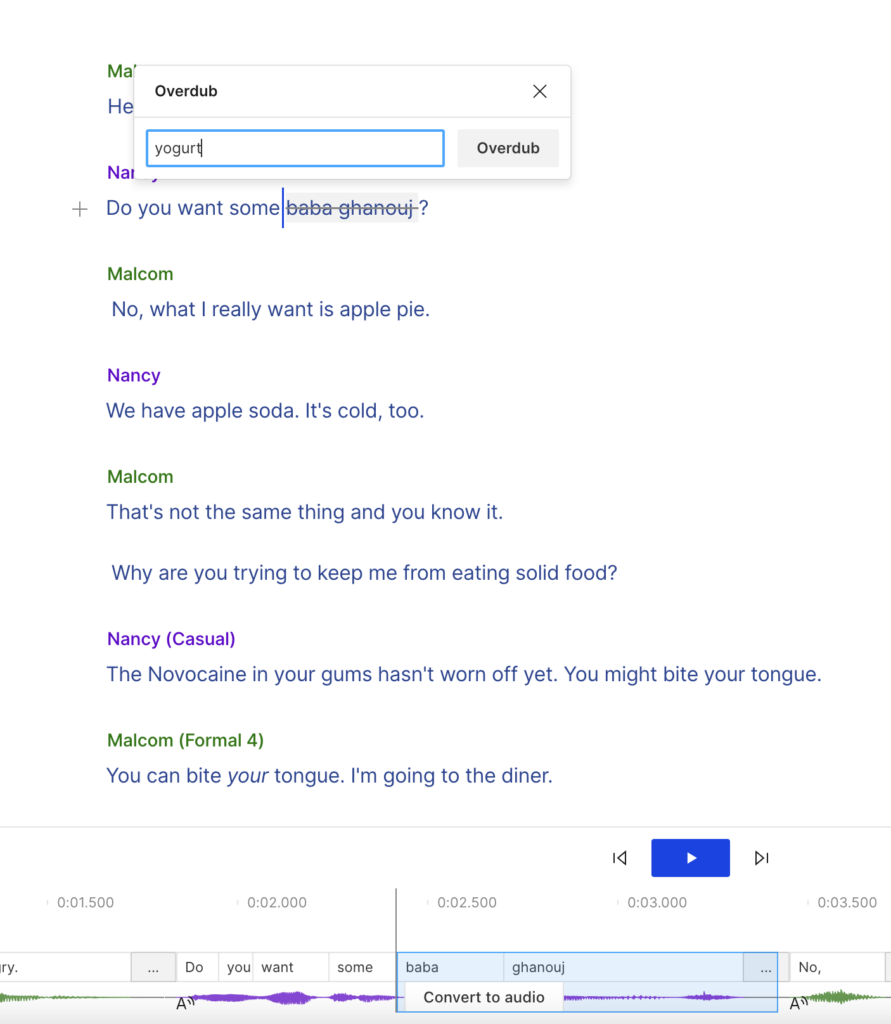
Can Descript Remove Filler Words?
Yes. Vocal sounds that Descript doesn’t recognize or can’t transcribe (such as laughter or other disfluencies) show up on the recording track with a black waveform. If you know the word, you can highlight it and correct it.
If you use words like “um” or “uh,” which Descript recognizes, those words get a blue underline. In the upper right corner of the screen, select the image that looks like stars, and choose “Remove Filler Words.”
Descript shows a list of filler words in your composition and provides the options to delete, ignore, or correct each one.
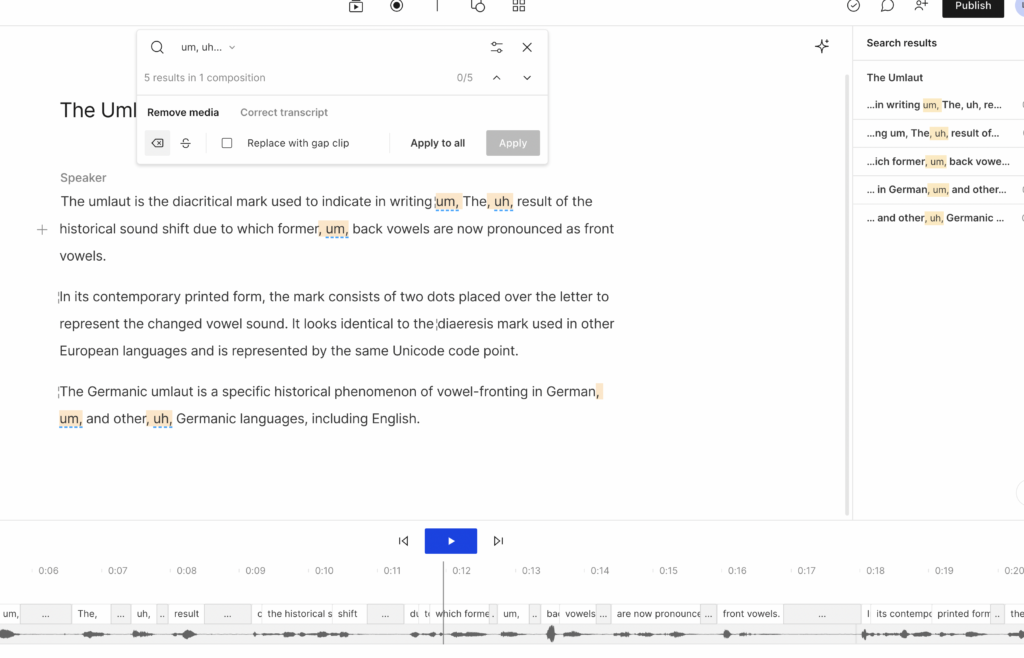
Descript removes “um” and “uh” at all price tiers, including free. At the Pro level, Descript can pinpoint and remove up to 18 filler or repeated words. Got a guest who can’t stop saying, “So he was like” or “and I was like?” Not anymore.

Descript Review: Video Editing Features
Descript has a step-by-step walkthrough in their Support system, plus a video tutorial. For the sake of brevity, I’ll show you the key features that make Descript’s video editing features different from other podcast maker apps.
Descript’s Script & Scene Editor vs. Timeline Editing
If you’re used to editing on a timeline, like in Adobe Premiere, iMovie, or Final Cut, you’ll have to learn a whole new paradigm to use Descript’s video editing features. Instead of a timeline, Descript uses Scenes and Script. The script is like a Word document, and the Scenes are like PowerPoint slides.
In the App preferences, change the default project type from Audio to Video. Descript divides the screen so that your Script is on the left and your Scene is on the right.
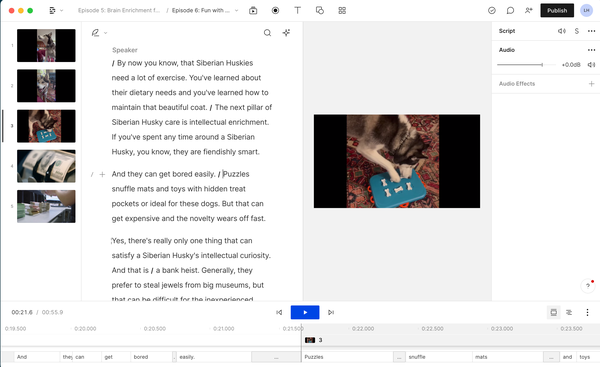
If you try to add an audio file to a video project, Descript will ask, “Did you want this project to be audio-only?” and vice versa. You can, however, record or write dialogue in a video project.
Descript Review: Video-first podcasting or audio-first?
And now, here’s what I learned the hard way.
If you upload your video first and that file has audio, Descript will transcribe and commit to keeping that audio for your project. If the audio is a dog barking, Descript knows it’s a disfluency and doesn’t transcribe it, but it leaves the audio. So, that blank transcript counts as the script, which you’re supposed to use to navigate the video interface. Don’t even try to change its mind. If you don’t want to use the audio from the video clips you use, detach and delete the audio in another software or app before uploading it to be safe.
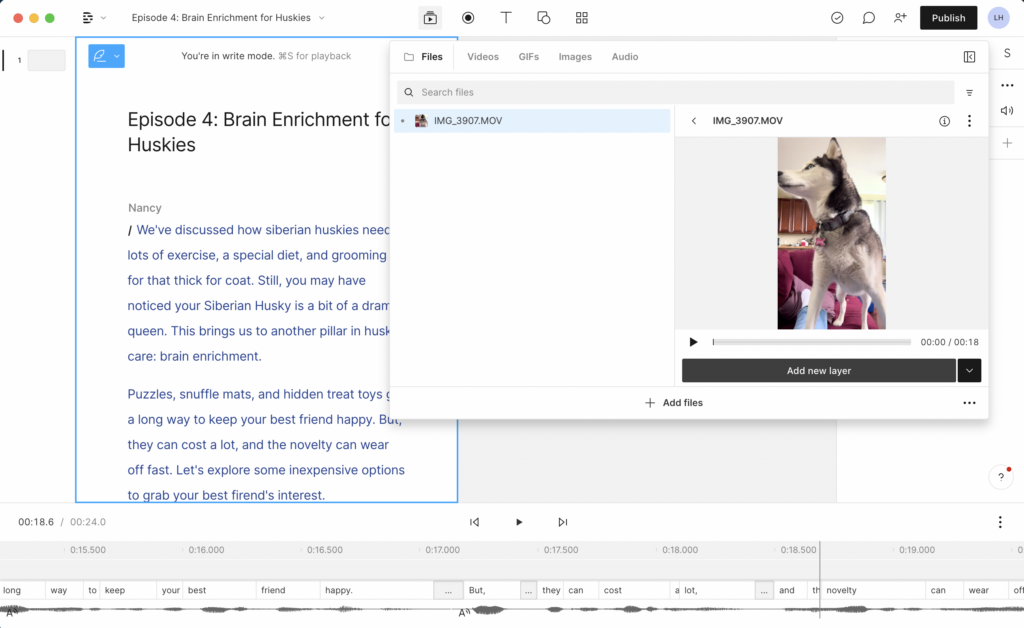
If you record your own audio in the Descript composition first, or if you write it in that composition and use one of the Overdub voices, Descript will allow that to be the audio for your podcast episode.
Even though video takes primary importance in a video project, once you’ve opened the composition, get the words into it first before you add the pictures. The words are what Descript uses to help you navigate the composition.
Script & Scene Vs Sequence or Timeline
In the video editing interface, Descript displays the scene rail (list of video clips) down the left, the script second from the left, the scene (video clip) that you’re actively working on second from the right, and on the far right, the properties of the scene you’re working on. The audio waveform is at the bottom of the pane.
To start a new scene, add a / to the text.
Descript has a sequence editor, which enables you to detach audio from video and then edit one or the other. But, Descript emphasizes, “to get the most out of Descript, the Script Editor should still serve as your primary location for editing.” Getting to the sequence editor requires patience. Once you have several scenes in order in your script, slide your mouse down to the bottom of the Script pane. On the dividing line between the Script and Scene panes and the waveform, if you hit the right spot, your cursor might turn into a toggle handle like this: ↕. Once you have that, click and grab the edge of the pane and pull up. This will show you all the layers in your composition: the video clips and the audio track.
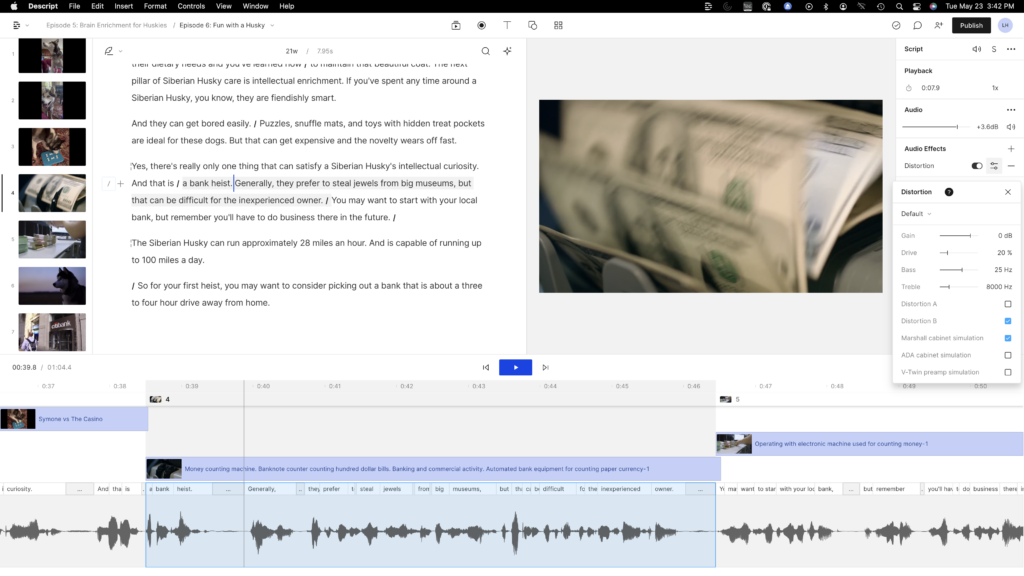
Voilá: it’s like pulling up a bedspread to reveal a timeline editor hiding under the bed, I mean, a sequence editor. Then, when you click on layers, you can edit them in the pane to the upper right.
Descript’s Video Templates Are Really Fun
Descript’s templates can save you a lot of video editing time. They can add images and text, adjust to different aspect ratios or fit multi-camera video podcasts. They can even overlay snow or rain.
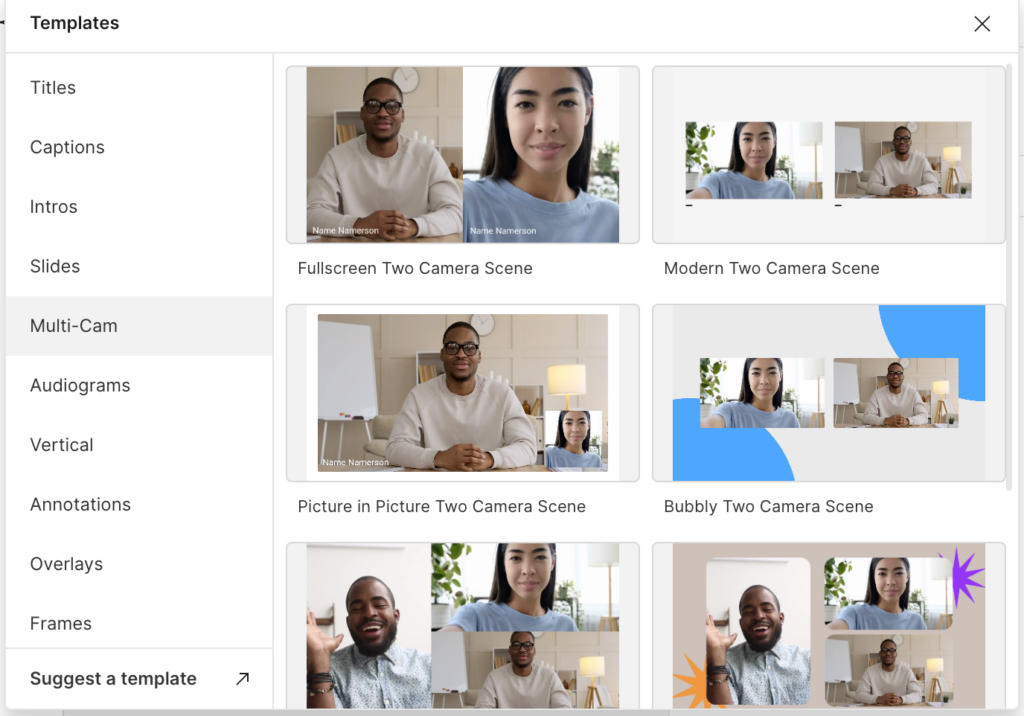
These video editing templates ensure all the layers are lined up properly so everything fits together and the medium doesn’t distract from your message.
Descript Overdub
Overdub is the feature that makes Descript seem like sorcery. You can copy and paste a text document into the editor, select an Overdub stock voice, and voilà, instant dialogue.
To go a step further, here’s where Overdub is unusually innovative. You can create a pre-recorded voice based on your own voice and speech patterns.
This has some great applications. For example:
If I want to change a word or a sentence in something I recorded yesterday but don’t have time to re-record it, I can type in different words. My Overdub voice will make it sound like me, saying the new words I typed in.
I can copy and paste old blog posts or things I’ve written into Descript. Then, I can select my pre-recorded voice to make audio files.

Descript is very careful to note that users can only make an Overdub voice of their own. You have to provide voice information, so you have to read a few pages of text. This can be anywhere from ten to ninety minutes: they recommend ten to thirty.
For this Descript review, I read the recommended ten. The Overdub voice that came out sounded enough like my own voice to whack me with the Uncanny Valley stick and make me run screaming from the room.
Spot the difference between the two Lindsays. I deliberately left in mouth noises and traffic from outside the open window.
If you want your Overdub voice to have emotion or attitude, you can record different styles. You record the sentence you want to be “happy” in a “happy” voice. Then, Overdub will use that information for other sentences you designate as “happy” in the future.
This really is a tool that can save you tons of time if you hate your voice or don’t want to record. But, the price difference is steep. If you need to use words outside of the 1000-word vocabulary, Descript replaces them with the words “jibber,” or “jabber,” and wow, is it surprising how embarrassing that is.
Descript Pricing
These prices below are the rate for an annual plan; you save 20%.
Free: This version lets you record and transcribe one hour of audio per month. Customers can export one watermark-free video per month with a 720p resolution. This tier includes filler word removal for ‘um” and “uh”, an Overdub vocabulary of 1000 words, and the stock library provides the first five results per search.
Creator: For $12 a month, you get everything in the Free version, ten transcription hours a month, unlimited watermark-free video export with a 4k resolution, and the video stock library provides the first twelve results per search.
Pro: For $24 a month, you get everything in Creator, plus 30 hours of transcription per month, and the filler word removal takes out up to 18 filler or repeated words.
Enterprise: The price isn’t advertised; you can contact them for pricing based on your company’s needs. You get everything in the other pricing structures, a dedicated account representative, higher usage limits, advanced sharing controls, a Master Service Agreement, Security Review, invoicing, and live onboarding and training.
Transcription accuracy can be improved for an additional fee of $2 per minute.

Descript Integrations
There is no shortage of options for linking your Descript account up with other software and services. You can publish podcast episodes directly to Captivate, Buzzsprout, Transistor, Castos, and Podbean. You can also import media from call recorders Riverside and Squadcast (who Descript recently acquired).
Descript Review: Summary
Descript, like any other product or service, has its pros and cons. One big plus, though, is that it certainly makes podcast recording and editing accessible.
Descript made me focus on the text on the screen, not the sound of the recording. The Overdub feature can be a useful asset. If I’d recorded the full 90-minute training document, I could have made the Overdub voice sound more natural. I could train it to sound like my voice in different emotional states. But, by the time I put all this effort into it, I may as well record the script myself.
This is a good tool if you’re mainly concerned about the text of your podcast and what’s spoken and transcribed. The video templates and features are really attractive, and they make the video features easy to use. Working on this Descript review shows me it’s an excellent tool for doctors, lawyers, journalists, or people who need a lot of dialogue recorded and transcribed quickly. It’s good for people who need to take text and make it into something people can listen to, quickly, too. The voices are pretty good. But, naturally, they’re not quite the same as a living human voice. You’re likely to make something which matches whatever this year’s popular aesthetic is on Instagram and YouTube, not something unique.
Our Rating: 4/5
- Value for price: 5/5
- Usage for Podcasts Specifically: 4/5
- UI: 4/5
- Ease of Use: 4/5
More Podcast Make App Options
As mentioned at the beginning of this Descript review for full disclosure, we also run our own podcast make app, Alitu. Alitu automates the technical parts of podcast creation, and gives you simple but powerful drag-and-drop tools to do the rest. Just like Descript, Alitu offers text-based editing options, too. You can also publish and host your podcast in Alitu, which isn’t something Descript offers at the time of writing.
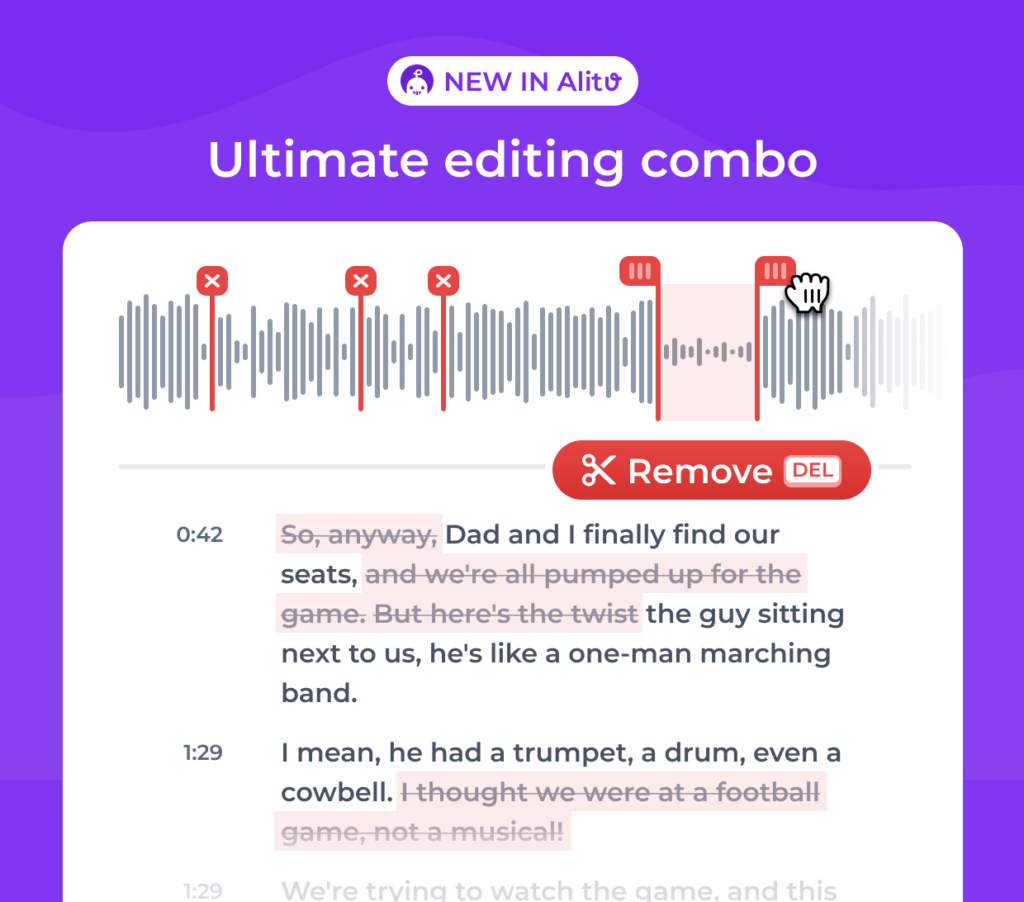
There are also a few other great podcast maker apps and Descript alternatives on the market, too. You’ll get a look through them by clicking the links to our dedicated roundups.
One thing is for sure, it’s never been easier to create a podcast with all the innovative and simplified tech options out there. So whether you opt for Descript, Alitu, or one of the others, you’ll likely free up more time to spend creating great content for your listeners. And there’s nothing more important than that when it comes to growing an audience!

